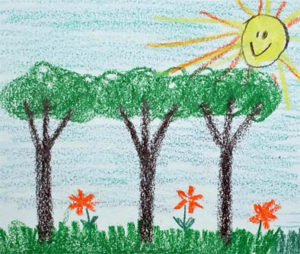

I can still remember the very first time my artwork was critiqued. The smell of Crayola’s hung thick in the air and every head in the classroom was bowed intently toward the paper in front of them. While I worked diligently on my landscape, our 2nd grade teacher silently walked behind our chairs pausing to inspect each student’s paper. I could feel her stop behind me and I held my breath knowing she was looking over my shoulder at my latest creation. Surely, I thought, she would love what I did. My beautiful trees stood equally spaced in a row with bright green leaves that topped tall, black trunks. I was so proud of my work-in-progress! And then she spoke. “Tree trunks are not black. Your drawing is wrong.”
Wait. What? I turned in my chair to look up only to see her disapproving face. She then stepped over to the next student at our table to deliver her verdict on their work. I looked back at my drawing and noticed that the once lovely piece I had already imagined showing my parents was no longer worthy. It was ugly. And how could I be so . . . dumb to “paint” the trunks black? Did anyone else hear what she said about my work? I was mortified before I even knew what that word was. So I folded it up and after class I threw the drawing away. After that I only wanted to color in the pages the teacher pulled from coloring books. I was afraid to draw what I wanted and when I did I most certainly would not draw anything without using appropriate colors. I was always worried I was “doing it wrong”.
Time passed and, like many of us do with unpleasant memories, I just tucked that day away someplace safe and dark. I pretty much forgot about it. Many years later in college I was in a class discussion about critiquing with fellow art students. I found most of us had stories that were similar to mine. When I shared my tale one student looked puzzled and said, “Haven’t you ever looked at trees after it rains? The bark is so dark it looks black.” Oh wow. She was right! First I had a moment of vindication. Then, interestingly enough, I actually felt sorry for my 2nd grade teacher because she had not had the eyes to see black bark for herself.
Of course, my first critique didn’t scar me for life. It may have temporarily stunted my desire to draw with abandon but I eventually got past that. I will say, however, that it made me more sensitive to other’s feelings when it comes to critiquing their work. Critiques play an important role in improving our creative endeavors and I think we do need those unbiased and objective pointers and suggestions from our peers. Listen and learn from artists you admire and know. Strive to continually improve your work. But always remember that it is your work and it comes from your heart. If you want to paint the bark black, go ahead and paint it black.
